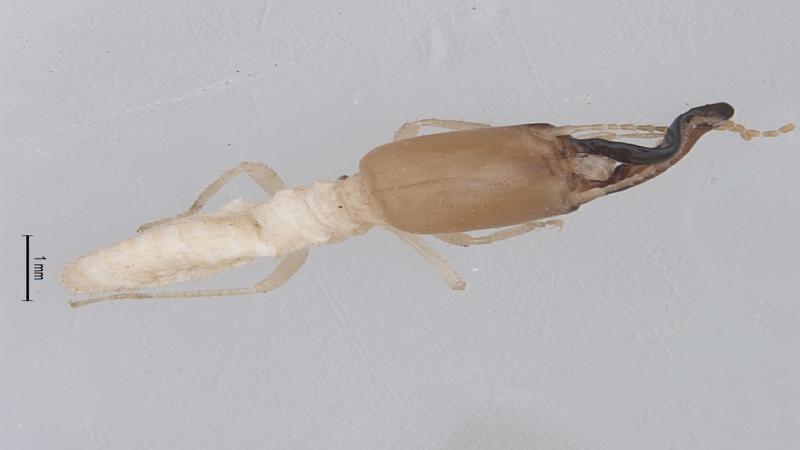
Termites are known for their social organisation, super-architectural abilities and most notoriously, for being pests. However, not all of them fall into the last category. Only about 12.5% of the world’s termite species are pests that cause immense economic damage. Their soil-dwelling counterparts, on the other hand, play an essential role in the natural world. They decompose tough plant fibres and recycle nutrients back into the soil.
In India, about 295 species of termites have been identified to date, accounting for almost 10% of the world’s termite biodiversity. In a recent study, scientists have discovered two new species – Krishnacapritermes dineshan and Krishnacapritermes manikandan – belonging to the Krishnacapritermes Chhotani genus. To date, this group of termites has been documented only in the Western Ghats of India. The termite species were named after Sri K.A. Dineshan and Sri. Manikandan Nair of the Zoological Survey of India, Kozhikode, who collected the samples from the field and contributed greatly to the entire faunal survey.

Krishnacapritermes dineshan | Credits: Zoological Survey of India.
The researchers discovered the new species while studying the termites collected from the soil underneath boulders in the forest of Kerala.“It was during a routine faunal survey by the Zoological Survey of India in 2014-15,” recalls Dr Amina Poovali, in an interview with Research Matters. She is a termite taxonomist and one of the lead authors of the current research.
“Since my PhD work was on the taxonomic studies of termite fauna of Kerala, I studied the specimens collected, and along with my guide, identified the two species as new to science,” she adds.
The study was a collective effort of scientists from the Zoological Survey of India - Calicut, Pune, Kolkata centres, Central University, Kasargod and CMS College Kottayam. Before this discovery, only two other species – K. maitii and K. thakuri were categorised under the same genus. The findings were published in the journal Oriental Insects.
The researchers used morphological features of ‘soldier’ termites to describe the species. Termites show a strict division of labour and in a colony a ‘soldier’ termite protects the nest while a ‘worker’ has labour duties of foraging and building the mound. However, finding ‘soldiers’ wasn’t simple!
“They are generally found in smaller numbers as compared to workers in the soil-dwelling termites”, explains Dr Poovali. “Sometimes, we may need to spend considerable time digging the soil for getting a good number. It all depends on our luck,” she says.
Back in 1997, a relatively low number of ‘soldiers’ was used to describe the same group. This effort led to the assumption that the termites lacked characters known as “anterolateral points” located on the edge of their labrum. The labrum is a flap-shaped structure in front of a termite’s mouth and functions as the upper-lip. In the current study, the researchers collected termites in plenty and observed intact, brittle, broken and folded anterolateral points in some specimens. Based on this, they redefined the generic characters of Krishnacapritermes genus.
Previous studies had shown that the termites were restricted to the Silent Valley National Park in Palakkad, Kerala and Tamil Nadu regions of the Western Ghats. However, the researchers found K. thakuri and K. maitii had extended ranges in the other montane areas of Kerala as well. On creating a distribution map for the four species, they further discovered that compared to other termites, Krishnacapritermes showed a greater affinity for high altitudes.
“Not all species can survive at the lower temperatures that prevail at high elevations,” says Dr Poovali, commenting on this finding. In fact, studies have found that termite diversity usually decreases with an increase in altitude.
Apart from this, the researchers conducted the first-ever DNA extraction and sequencing studies for the genus for the generation of DNA barcodes for species– K. thakuri and K. dineshan. DNA barcoding is a method used to identify organisms using a short chain of DNA sequences. The researchers found the latter to be an identifiable member of the Krishnacapritermes group and was closely related to K. thakuri in the phylogenetic tree—a diagram that represents the evolutionary relationships among organisms.
Interestingly, two ‘worker’ individuals found in a K. dineshan nest belonged to another genus known as Dicuspiditermes.
“Different species of termites live in the same habitat. They may have their own separate galleries and nests underneath the soil,” says Dr Poovali, explaining this phenomenon. The collection of termites disturbs the soil and individuals of different species may get mixed up. “The association of genus Dicuspiditermes with other termite genera have already been reported. But until and unless we encounter this phenomenon repeatedly, we cannot comment much on their intergeneric social interactions,” she adds.
The discoveries of termite species indicate that there could be several other species awaiting scientific documentation, especially in the biodiversity hotspot of the Western Ghats.
This article has been run past the researchers, whose work is covered, to ensure accuracy.





